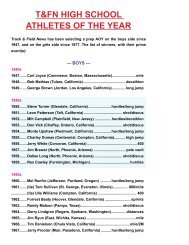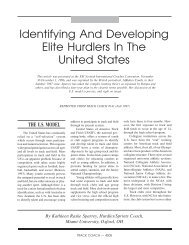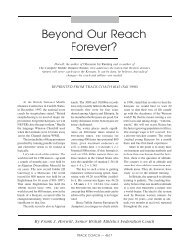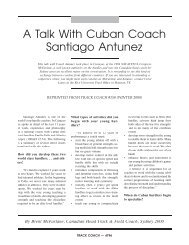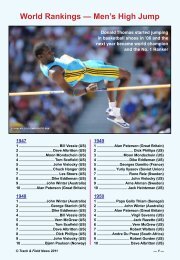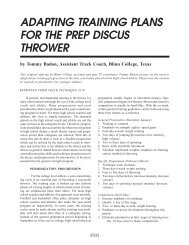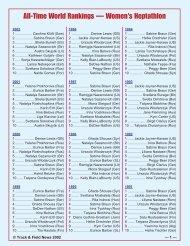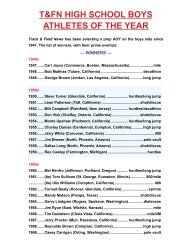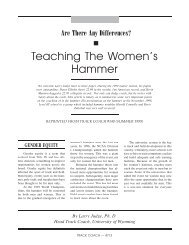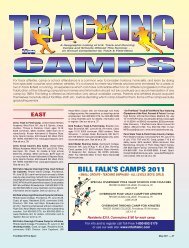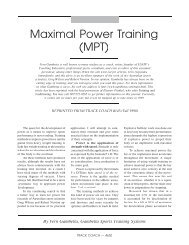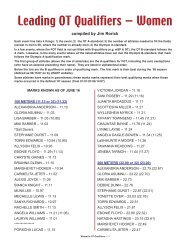SPEED TRAINING - Track & Field News
SPEED TRAINING - Track & Field News
SPEED TRAINING - Track & Field News
Create successful ePaper yourself
Turn your PDF publications into a flip-book with our unique Google optimized e-Paper software.
4x100, 4x50).<br />
Fri: Rest/travel/light<br />
Sat: Meet or time trial or speed endurance/speed technique<br />
as needed (light activity if needed).<br />
Sun: Weights on own.<br />
Peaking Cycles IV and VI<br />
Mon: Speed and technique: 3x100, to 95%; 3x60m finish<br />
60s; 6 x starts.<br />
Speed endurance-3x200 with 10 min rest at<br />
99%, or 1x300/1x200, with 10-20 min rest at<br />
99%.<br />
Wed: Light as needed, weights.<br />
Thu: Speed and technique: 6-10x30-100m.<br />
Fri: Rest/travel if meet Sat; light or rest if not.<br />
Sat: Meet or as needed (e.g., 2x200 with 10-15 min<br />
rest @ 95-99%).<br />
Sun: Meet?? or light, weights on own.<br />
Mon: Light speed endurance—1x200 99%, 3x100 accelerations<br />
to 95% or in-outs, 3x50, 20m running<br />
start, 99%.<br />
Tue: Speed Technique as needed—8-12 reps 30-100m<br />
Wed: Travel/light shake-out: 6-8x30-60m accelerations<br />
to 90-95%.<br />
Thu: Rest or light speed technique: 6-8x300-60m.<br />
Fri: Meet (Qualifying rounds?)<br />
Sat: Meet (Finals)<br />
Sun: Meet? Rest/travel?<br />
FOOTNOTES<br />
1. Sprinting speed is used to denote the ability to sprint<br />
at maximum speed where fatigue is not a factor—e.g.,<br />
time over a 30m flying start sprint.<br />
2. “A Study of the 400 Meters,” Letzelter, Manfred<br />
and Eberhard Stroot, FRG, Sprints And Relays, Jess Jarver,<br />
ed., Tafnews, 1983, pp 46-49.<br />
3. “Modern Trends in Strength Training”, Tschiene,<br />
Peter. The Throws, Jess Jarver, ed., Tafnews, 1980, pp.<br />
17-19.<br />
4. “The Biomechanical Analysis of Sprinters,” Mann,<br />
Ralph, <strong>Track</strong> Technique, No. 94, Winter 1986, p. 3000-<br />
3003.<br />
5. Various sources list the endurance of the ATP-CP<br />
(alactic) energy system as 5-15 seconds of 100% activity.<br />
In practice, it can be seen as the dominant energy system<br />
for the 100 and 200.<br />
6. As of December 1986, we have some short sprinters<br />
who feel they are missing something from not doing<br />
repetitions of 500m or the like. We are adjusting the<br />
training schedule to meet this psychological “need.”<br />
7. “Modern Trends in Strength Training”, Tschiene,<br />
Peter, The Throws, Jess Jarver, ed, Tafnews, 1980, pp.<br />
17-19.<br />
8. “The Biomechanical Analysis of Sprinters,” Mann,<br />
Ralph, <strong>Track</strong> Technique, No. 94, Winter 1986, pp 3000-<br />
3003, (USOC-TAC Elite Athlete Project).<br />
9. The general words “relaxed” and “tension” are used<br />
in lieu of a long explanation of antagonist and agonist<br />
muscle activity, and the contraction-relaxation sequences<br />
of the sprint stride.<br />
10. By intuition, or intuitive logic, we mean the ability<br />
to make conclusions, judgments, or perceptions based on<br />
a deep background and reasonably thorough knowledge<br />
of the area, without direct inductive or deductive links to<br />
the conclusions. Intuition, here, is a well-reasoned hunch<br />
hopefully based on experience, previous knowledge, and<br />
measurements.<br />
3294



